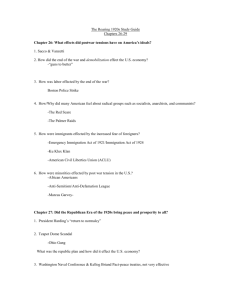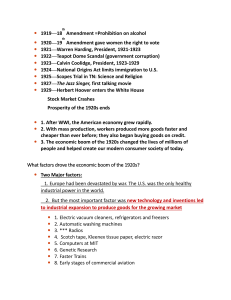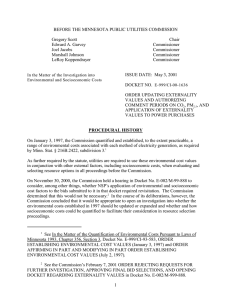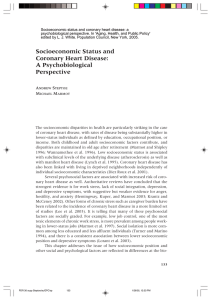MASS PRODUCTION
advertisement
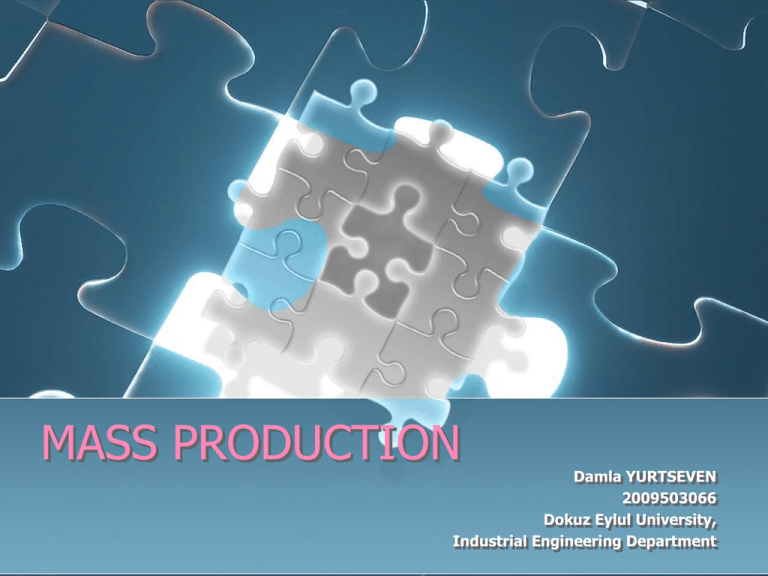
MASS PRODUCTION Damla YURTSEVEN 2009503066 Dokuz Eylul University, Industrial Engineering Department CONTENTS: Overview History Advantages Disadvantages Effects on The Organization of Work Socioeconomic Impacts OVERVIEW Mass Production is a system of manufacturing based on principles such as the use of interchangeable parts, large-scale production, and the high-volume Assembly Line. OVERVIEW Mass production, although allowing lower prices, does not have to mean low-quality production. HISTORY Mass production was popularized in the 1910s and 1920s by Henry Ford's Ford Motor Company, which introduced electric motors to the then-well-known technique of chain or sequential production. HISTORY Ford also purchased or designed and built special purpose machine tools and fixtures such as multiple spindle drill presses that could drill every hole on one side of an engine block in one operation and a multiple head milling machine that could simultaneously machine 15 engine blocks held on a single fixture. All of these machine tools were arranged systematically in the production flow and some had special carriages for rolling heavy items into machining position. Production of the Model T used 32,000 machine tools. ADVANTAGES The worker spends little or no time retrieving and/or preparing materials and tools, and so the time taken to manufacture a product using mass production is shorter than when using traditional methods. The probability of human error and variation is also reduced, as tasks are predominantly carried out by machinery. ADVANTAGES An increased rate of production, enables a company to produce a larger quantity of one product at a lower cost than using traditional, non-linear methods. DISADVANTAGES Mass production is inflexible because it is difficult to alter a design or production process after a production line is implemented. All products produced on one production line will be identical or very similar, and introducing variety to satisfy individual tastes is not easy. DISADVANTAGES BUT; With each passing decade, engineers have found ways to increase the flexibility of mass production systems, driving down the lead times on new product development and allowing greater customization and variety of products. EFFECTS ON THE ORGANIZATION OF WORK The development of mass production transformed the organization of work in three important ways. 1) Tasks were minutely subdivided and performed by unskilled workers, or at least semiskilled workers, since much of the skill was built into the machine. EFFECTS ON THE ORGANIZATION OF WORK 2) 3) Manufacturing concerns grew to such size that a large hierarchy of supervisors and managers became necessary. The increasing complexity of operations required employment of a large management staff of accountants, engineers, chemists, and, later, social psychologists, in addition to a large distribution and sales force. SOCIOECONOMIC IMPACTS Mass production improved productivity, which was a contributing factor to economic growth and the decline in work week hours, alongside other factors such as transportation infrastructures (canals, railroads and highways) and agricultural mechanization. These factors caused the typical work week to decline from 70 hours in the early 19th century to 60 hours late in the century, then to 50 hours in the early 20th century and finally to 40 hours in the mid 1930's. SOCIOECONOMIC IMPACTS Overproduction was a result of mass production. Using a European crafts system into the late 19th century it was difficult to meet demand for products such as sewing machines and animal powered mechanical harvesters.By the late 1920s most goods were over supplied, which contributed to high unemployment during the Great Depression. Mass production allowed the evolution of consumerism by lowering the unit cost of many goods. THANKS FOR LISTENNING




